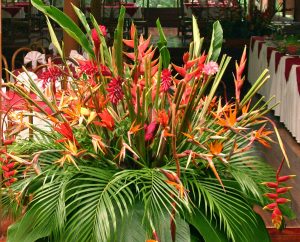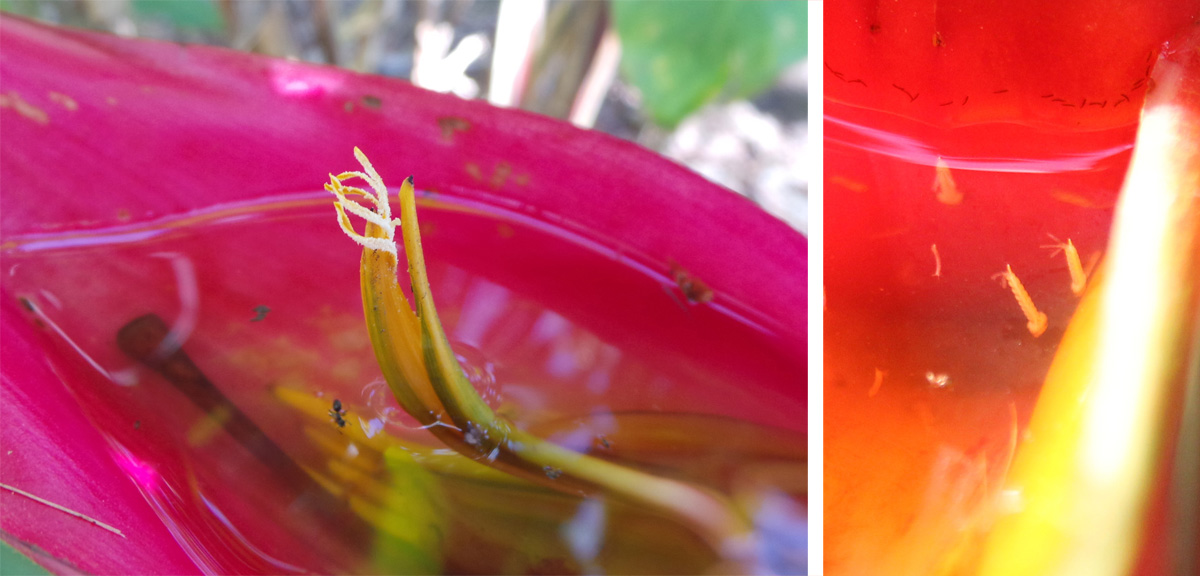
Heliconias are one of the most showy, distinctively tropical flowers with beautiful, brilliant colorful flowering bracts. There is only a single genus (Heliconia) in the family Heliconiaceae, with about 200 species. Most are native to the neotropics (tropical America), but some are from the Pacific Islands west to Indonesia. Formerly classified in the banana family (Musaceae), the leaves and their general shape do resemble banana and bird of paradise (Strelitziaceae), but the flowers are very different. They are one of the most common floral components of the understory of wet neotropical forests at low and mid elevations. Many types are grown for the florist’s trade and as landscape plants. Several cultivars and hybrids have been selected for garden planting in tropical areas. Because they are not at all frost hardy, they would have to be grown as container plants in the Midwest — or just enjoyed as long-lived cut flowers imported from milder climates. The smaller cultivars will be easiest to keep as container plants; most need full sun, humidity and warm conditions year-round, making them challenging to grow in our climate.
These are medium to large plants, often with extensive rhizomatous growth, that can be up to 30 feet tall and may form large clumps. Each erect stem is technically a pseudostem, made up of many overlapping sheathing leaf bases. Each stem has a number of banana-like leaves arranged in one plane (distichous) and often, although not always, has a terminal inflorescence. Leaves are usually green, but some may be tinted maroon or red below. In some species the blades split with age, or have a white, waxy coating. The end of the leaf is almost always pointed and the base is nearly always unequal, with one side extending farther along the petiole than the other side. There are three basic types of leaf arrangement found in the genus Heliconia, which are normally constant within a species. The leaves may be upright with long petioles — with the growth habit of a banana plant (“musoid”); more or less horizontal with short petioles — the way a ginger plant grows (“zingiberoid”); or have short to medium-length petioles and blades held obliquely — similar to that in Canna (“cannoid”). Some plants may be intermediate between these basic forms.

Once a plant is mature, each shoot has the potential to generate a single inflorescence. The inflorescences are almost always terminal and may be either erect or pendent. Erect heliconias stand straight with bracts pointing up. Pendent heliconias hang down with bracts pointed toward the ground. The inflorescence is made up of the peduncle (the part of the stem between the terminal leaf sheath and the basal bract), inflorescence bracts (also know as spathes), the rachis connecting adjacent bracts, and a coil of flowers within each bract. The rachis may differ from the bracts in color and texture and is either straight or zigzag. The bracts are either distichous or are spirally arranged due to twisting of the rachis. In some species, the rachis is only slightly twisted, making the bracts semispirally arranged or are distichous when young, but become spiral as all the bracts mature.

The inflorescence bracts are usually bright red, yellow or both, but they are sometimes green, orange, purple or pink, and may be smooth or fuzzy. The fairly inconspicuous green, yellow, or orange flowers are enclosed by the spectacular, long-lasting waxy bracts. Each bract has up to 50 flowers, the number depending on the species.

The mature fruit of Heliconia is a drupe (like a peach), with a hard inner layer enclosing each of the true seeds (one to three per fruit). The outer layer of the fruit is fleshy and at maturity the surface layer becomes blue in American species or red to orange in South Pacific species. The colorful fruits are very attractive to the birds and mammals that disperse the seeds. The inflorescence may last from several days to several months, but eventually ceases to produce flowers and fruits, turns brown, and dries up or rots away. After that the entire shoot will also die as new shoots begin to grow from the underground rhizomes.

The flashy colors of the bracts attract the hummingbirds that pollinate the flowers. The flowers come in a variety of lengths and shapes, which correspond to the length and shape of the bill of their pollinator. Curved flowers are adapted to pollination by hermits which have long, curved bills. Other hummingbird species pollinate different Heliconia species, which deposit pollen on different parts of the bird making transfer of the pollen to the next individual of that species likely to occur. Other nectar-feeding birds will also visit the flowers.

Heliconias are important to other birds and animals as well, both for food and shelter. Some of the hermits also use the plant for nesting, attaching their elongated nests to a strip of leaf torn away from the blade so that the leaf provides an overhang for the nest. Furled leaves provide hiding places for spiders, frogs and disk-winged bats. Many tiny aquatic organisms live in water that collects in the bracts of species with erect inflorescences.

Honduran white bats (Ectophylla alba) and at least two other species of bats roost in “tents” they make by chewing the side veins along along the leaf midvein to make the leaf droop down on both sides.

The larvae of owl butterflies (Caligo spp.) feed on heliconia leaves and all stages of the heliconia bug, Leptoscelis tricolor, are spent on the inflorescences.


– Susan Mahr, University of Wisconsin – Madison
Latest from Wisconsin Yard & Garden
Ask Your Gardening Question
If you’re unable to find the information you need, please submit your gardening question here:





 Aster, Symphyotrichum spp.
Aster, Symphyotrichum spp. Fascinating Fasciation
Fascinating Fasciation Alternatives to Lawn: Groundcovers
Alternatives to Lawn: Groundcovers Marigolds
Marigolds


